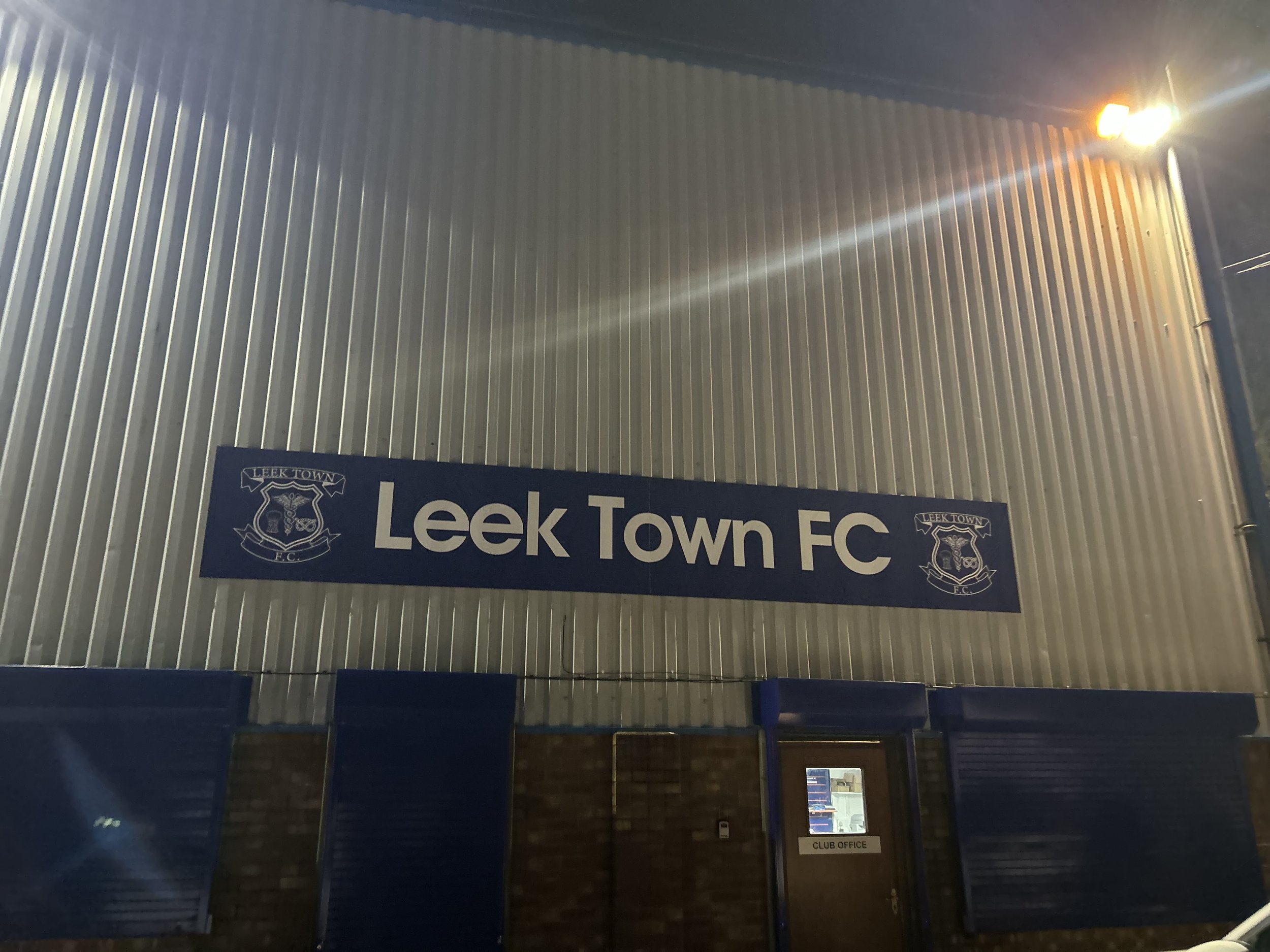Leek Town vs Hanley Town. 07.11.23
Joe Marshall- @joemarshall_
There is not much in English football that has established a more iconic reputation than midweek football in Staffordshire. While one particularly overused phrase may spring to the minds of many, I looked further down the pyramid for my football fix.
Instead of the infamous bet365 and Stoke City, I visited the impressive Harrison Park, home of Leek Town for their Northern Premier League West derby against a side visiting from the Potteries; Hanley Town.
Leek
Leek itself is a town of around 20,000 people, situated around 10 miles north of Stoke-on-Trent. It is situated in north Staffordshire, not too far from the county’s northern border with Cheshire. More specifically, Leek lies in the Staffordshire Moorlands District, and has earned the historic moniker of “The Queen of the Staffordshire Moorlands.” It has been a market town for hundreds of years, and modern life in the town reflects those traditions, with a Wednesday market still in operation, but now accompanied by an array of independent shops and pubs. During the north’s industrial past., the silk and textiles sectors were hugely influential in the town. With Leek’s close border with Cheshire, the Silk Road connects Macclesfield in the north to the Staffordshire town.
Harrison Park
Leek Town’s home is the 3,600 capacity Harrison Park, or as it is now known, the F. Ball Community Stadium. It took its original name from former chairman Geoff Harrison. Due to its location on Macclesfield Road, one of Leek’s busiest routes, it is a recognisable landmark for commuters passing through on their way to Stoke in the south, Manchester in the north or anywhere in between.
The exterior of the ground is busy with advertising, catching the eyes and the attention of commuters passing by. Immediately aside from the main road, a sudden and easily missed pathway takes supporters down towards the main stand and the turnstiles. There is no parking at the ground, so most fans choose to park on the nearby streets, however there is a retail park close by which the club encourage you to use. Unfortuntately, Leek’s railway station closed back in 1970, meaning that public transport access is a little harder. The nearest major towns and cities are the aforementioned Stoke and Macclesfield, from which you can catch the bus into Leek itself.
Harrison Park is an impressive traditional non-league ground. It has been home to Leek Town since 1948, but has several new furnishings that have brought it into the present day.
All four sides of the ground are able to boast a stand of some description, however it is the striking main stand which immediately catches the attention. This large and impressive structure can seat over 600 people, as well as a couple of hundred more on small sections of uncovered terrace by the steps. Its unique structure is intriguing, and offers fantastic vantage points from all levels.
Opposite the main stand is a small terrace which is partially covered. The covered area stretches for almost half the length of the pitch, and is also the home of some disused turnstiles which remain to maintain the character in this old ground.
Behind both goals are covered terraces which are a couple of steps high. These two stands are almost identical, and are covered for the full width of the pitch.
The playing surface is 4G, which is a growing trend in non-league, as teams look for ways to keep games on in the winter, as well as expand revenue streams and get more teams playing on the pitch. Despite my usual aversion to artificial surfaces, the 4G gave me a reassurance of seeing a game, as the level of rain in recent days had already put pay to several other games that evening. Additionally, the overhanging branches coupled with the autumn wind had blown plenty of leaves onto the pitch, adding a garnish of nature to the artificial surface.
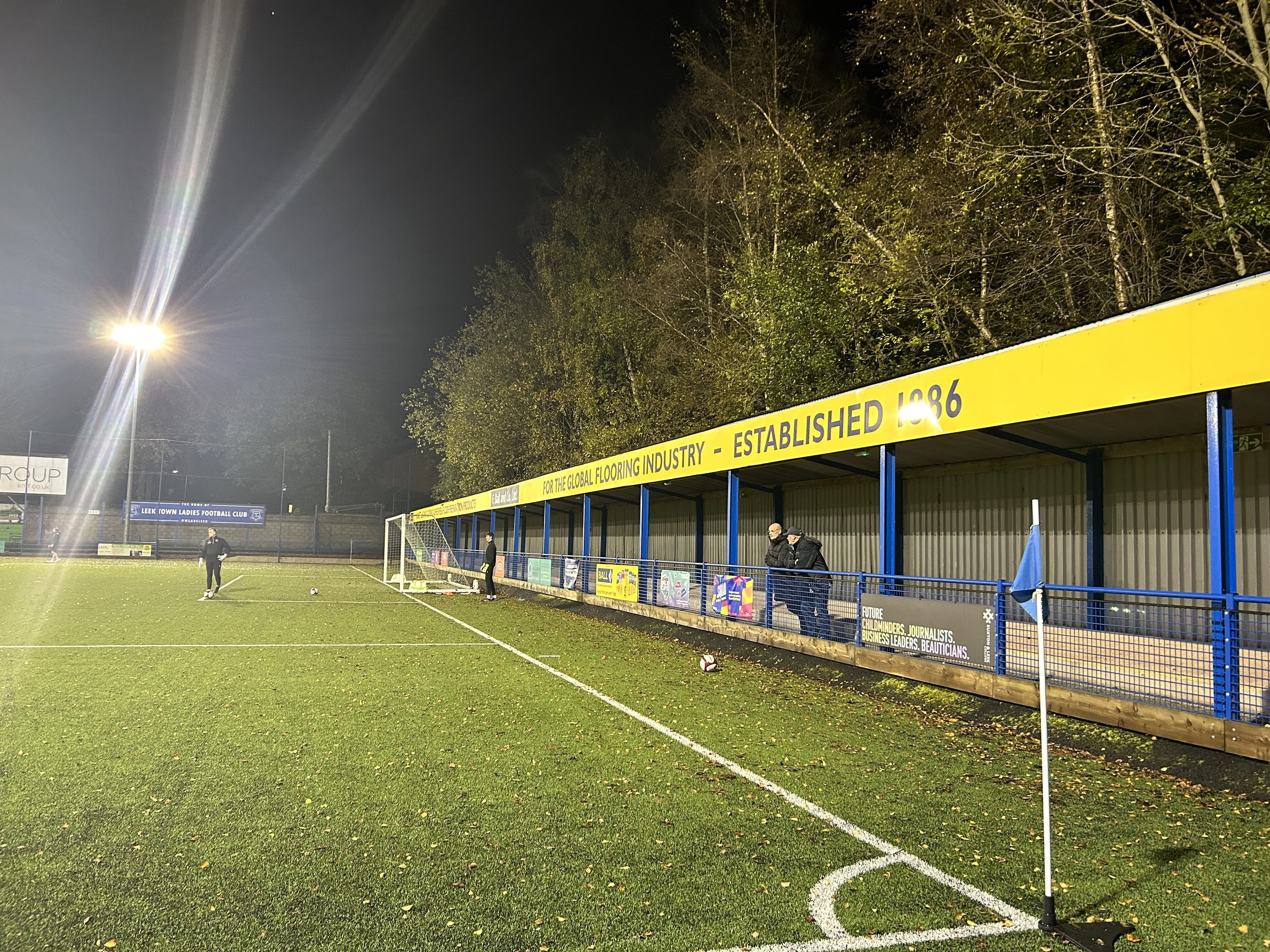

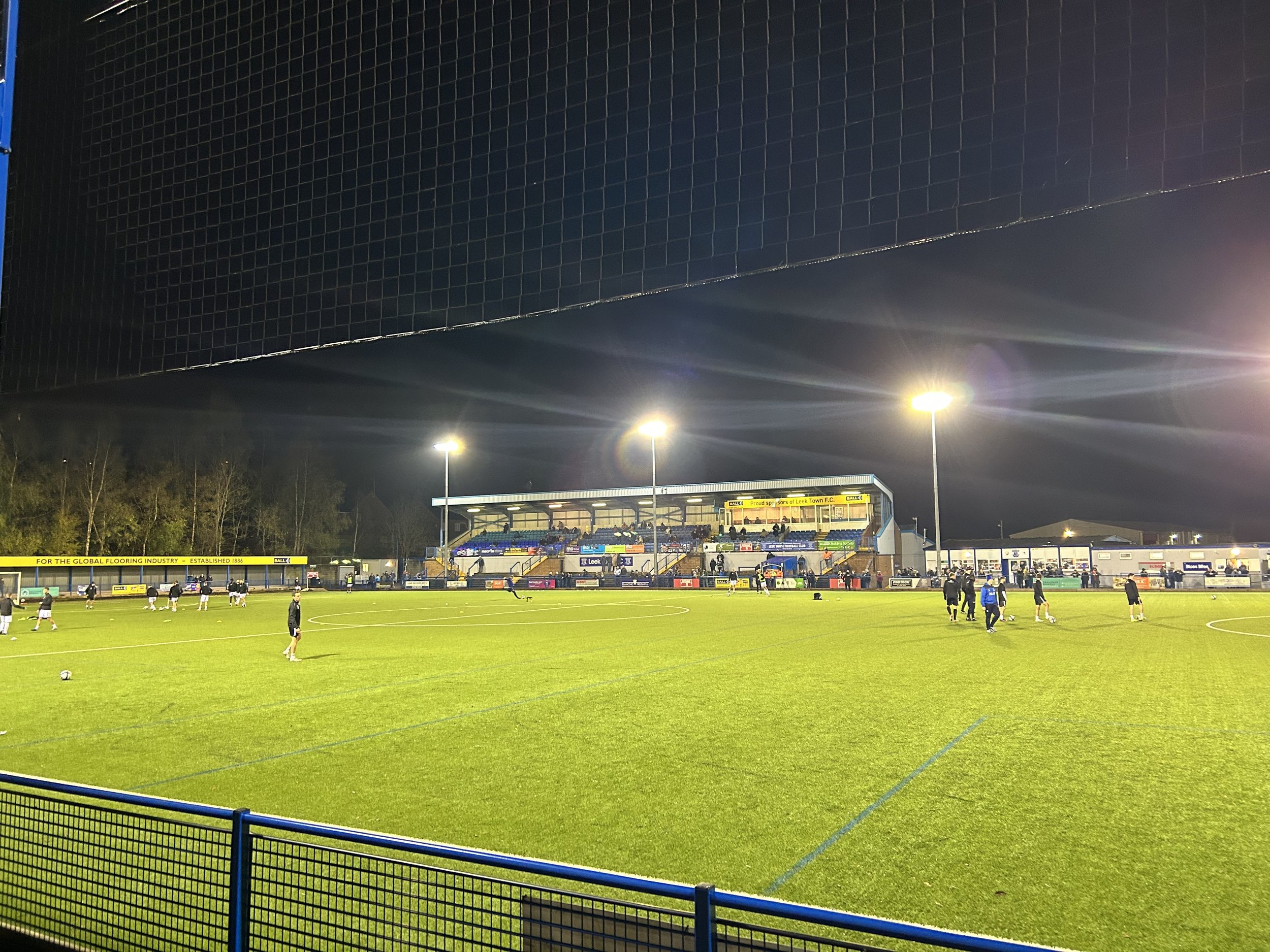


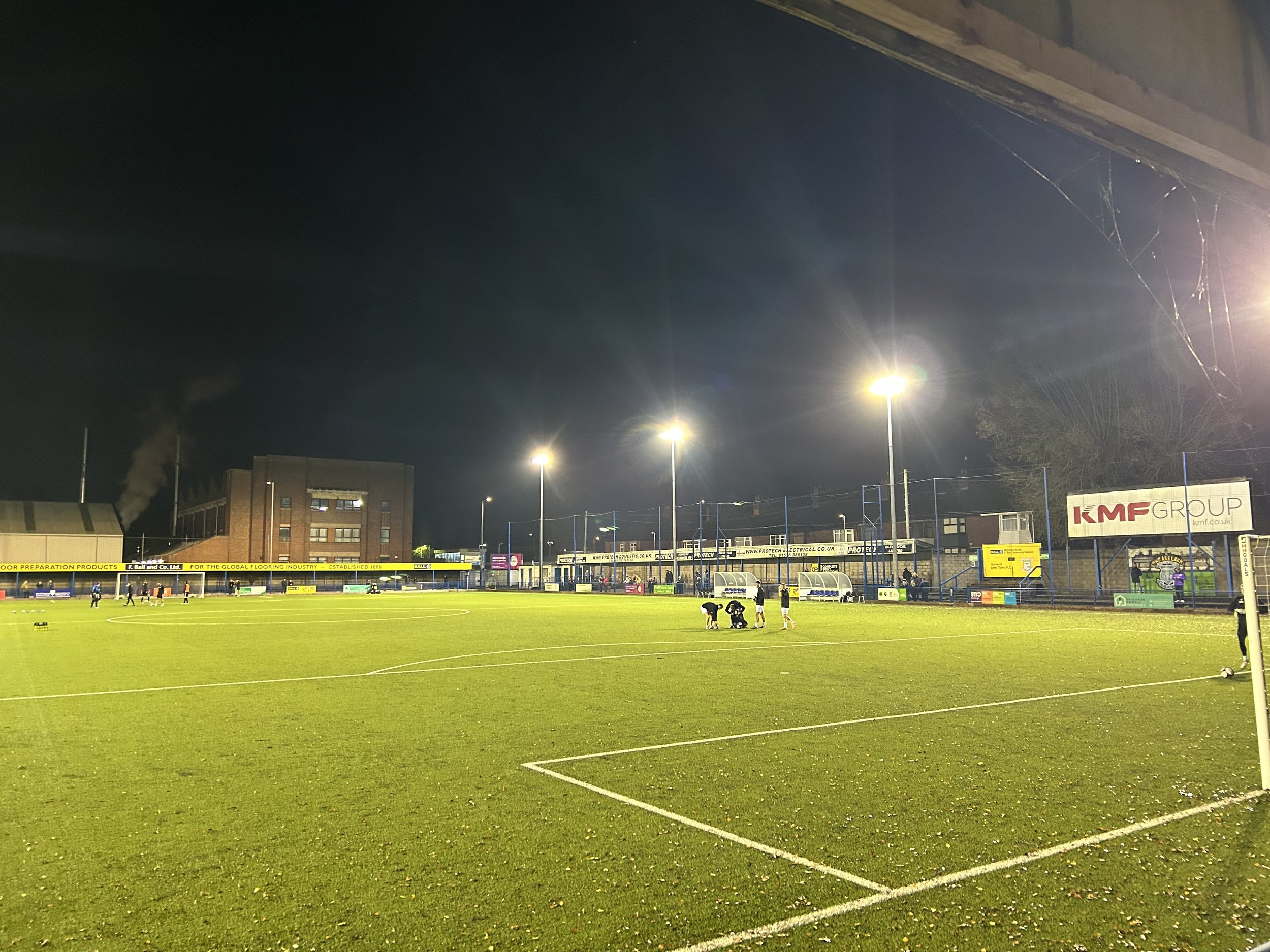
Harrison Park Experience
After a friendly welcome as I passed through the turnstiles and bought a programme, I began to wander around the ground. One of my first stops was the large ‘Blues Bar’ clubhouse, situated next to the main stand, which served a great range of alcoholic and soft drinks (but no alcohol free lager sadly). It also had a pool table, plenty of seating and televisions showing the evening’s Champions League action.
Outside the clubhouse was a large area which I could see being a great space to socialise with a drink in the summer months. However, due to the November cold, most people chose to congregate inside instead.
Taken during the game, obviously
Next door to the ‘Blues Bar’ is the ‘Blues Bites’ food bar. I sampled a meat and potato pie with mushy peas which was excellent in its taste and temperature. A healthy portion size of peas was much appreciated and coming in at £3.50, it was great value, too.
Idea for the future. If you want to praise food, don’t get mushy peas. They’re not flattering.
By far one of the best parts of the Harrison Park experience is the wonderfully put together matchday programme. 52 glossy pages of content comes at the price of just £2.50, and unlike other programmes, it isn’t bulked out with anabolic advertisements. With excellent features from the chairman and manager, articles and stats from the league, in depth opposition reports and detailed statistics, the publication has everything you would want and more.
Leek Town History
Football is believed to have been played in Leek since the late 1800s, but the story of Leek Town as we know it began in 1946, under the name of Leek Lowe Hamil. They began in the Leek & Moorlands League, followed by a move into the Staffordshire League. After an unbeaten league season in 1950, they progressed into the Manchester League with their new title of Leek Town.
Throughout the 1950s, Leek Town would have a nomadic experience, with various spells in the Manchester League, Birmingham & District League and Mid-Cheshire League, before settling into a more consistent existence when they returned to the Staffordshire League ahead of the 1959/60 season. This would lead to a successful era for the club, with back to back titles in 1962 and 1963 and consistently high league finishes in the following seasons. This period also saw the ground undergo several stages of development, such as the installation of floodlights and a clubhouse.
The 1970s saw a continuation of this success, with division titles in the Staffordshire, Cheshire and Manchester Leagues during the decade. When the North West Counties Football League was established in 1982, Leek Town became founder members. Five years later, they were amongst the founding members of the Northern Premier League.
The 1989/90 season was to be an historic one for Leek, with a trip to Wembley for the FA Trophy final. Despite losing 3-0 to Barrow, they completed a memorable season by clinching the NPL Division One title.
Matchball and programme from the 1990 FA Trophy final. Credit: X (Twitter) Rob Filby @Bobso1902
In 1994, they were denied a place in the Vauxhall Conference due to financial reasons, and were instead moved laterally to the Southern League after a second place finish in the NPL Premier. They returned to the NPL after one season in exile, in which they achieved a creditable 7th place finish. Once back in the Northern Premier League, they continued where they left off and gained promotion to the Conference in 1997.
This was to be the apex of Leek Town’s climb up the non-league ladder. They spent two seasons in the Conference before returning to the NPL thanks to relegation in 1999.
Since then, Leek have gone through a settled period on the pitch, but financial trauma off it. In 2007, the club was saved from a winding up order after a consortium came to their rescue. In more recent times, Leek Town will have more reason than most to bemoan the curtailed seasons of 2019/20 and 2020/21. On both occasions, they sat at the top of the table when the pandemic took hold, denying them the chance to complete promotion back to the NPL Premier Division
The Match
Leek’s opponents were local rivals Hanley Town. Based less than 10 miles away in the northeast of Stoke-on-Trent, both sides understandably saw it as a local derby. This was reflected by the healthy number of visiting supporters that were dotted sporadically around the ground, in addition to the large gathering of Hanley fans congregating behind the Leek goal.
Before kick off, Leek sat in 4th place, 8 places but only 4 points above their rivals. The signs pointed to an entertaining match that Leek should edge. However, it was Hanley who came flying out of the traps. Playing with a high intensity, they spent the first 10 minutes in control of the ball and took up almost permanent residency inside the Leek half. The standout performer in the early exchanges was the eye-catching Luke Walsh, who showed excellent style, dribbling and vision to unlock the Leek defence on a number of occasions. It was his defence splitting pass which set up the first goal. Picking up the ball wide on the right touchline, he came inside and threaded a perfectly weighted pass through to Tyrone Ofori who fired into the roof of the net from an acute angle.
Hanley continued to keep their foot on the accelerator and got themselves into dangerous areas with ease. On one such occasion, Jake Twyford believed he was fouled when he twisted and turned to find space in the box, but the referee punished him instead for simulation.
Leek soon found themselves with more possession and eventually more territory. After a couple of free kicks passed without any danger, a terrific set-piece strike from Dan Trickett-Smith sailed into the bottom corner. The dead-ball chance came after Saul Shotton fouled a Leek attacker on the edge of the box, for which the Hanley defender received a booking.
Minutes later, and the cousin of Hanley player-manager Ryan Shotton (who was also in action) was to regret his earlier caution for more than just the goal it led to. As Leek broke down the left with Rob Stevenson, Saul Shotton ended the attack by fouling the Leek man just outside the penalty area, an offence which the referee deemed worthy of a second yellow, meaning he saw red. Hanley, despite their bright start, had lost their lead and were down to 10. The Leek fans in their holy ground behind the goal clearly took great pleasure in telling the Hanley man that its time to go.
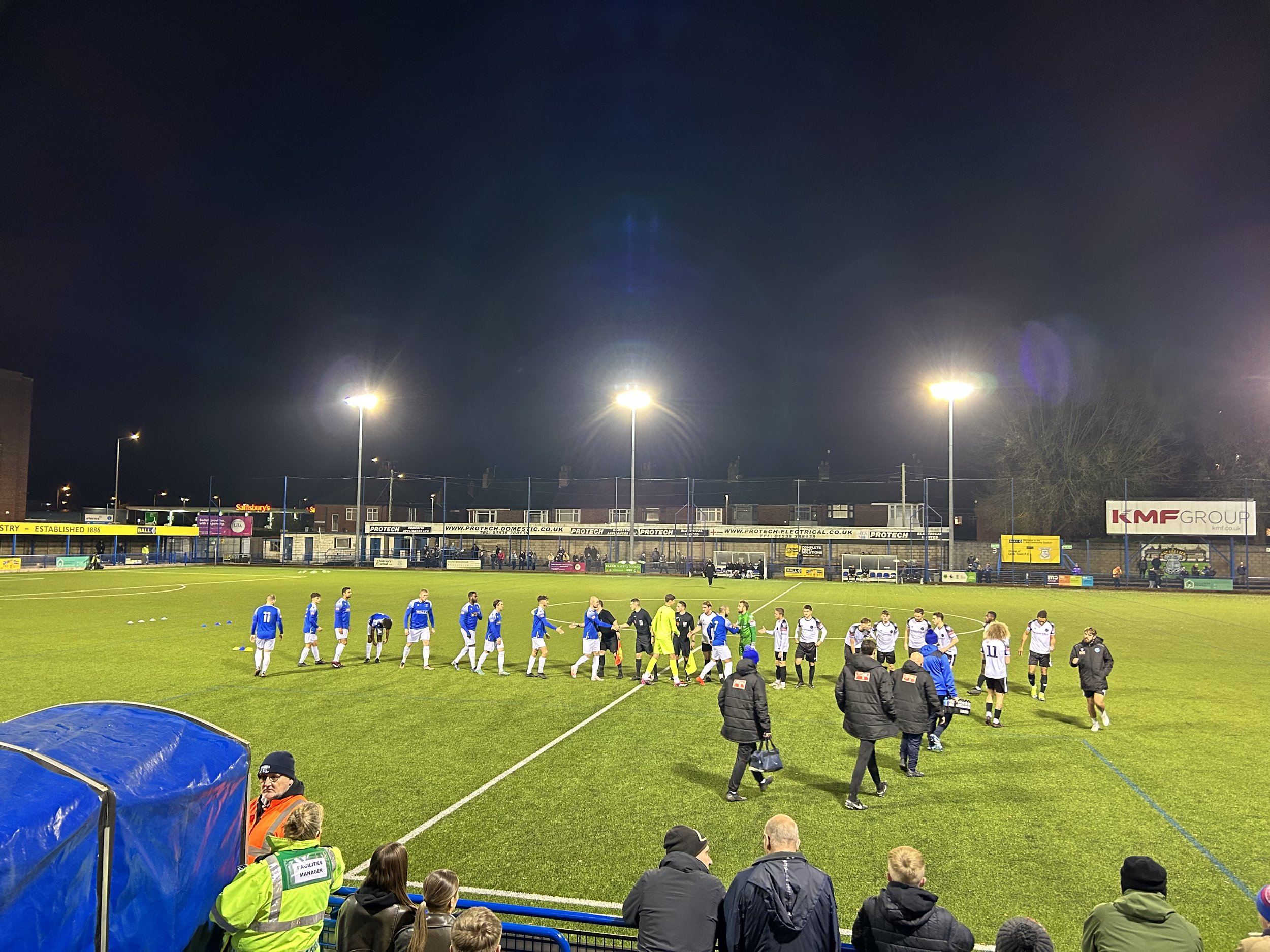
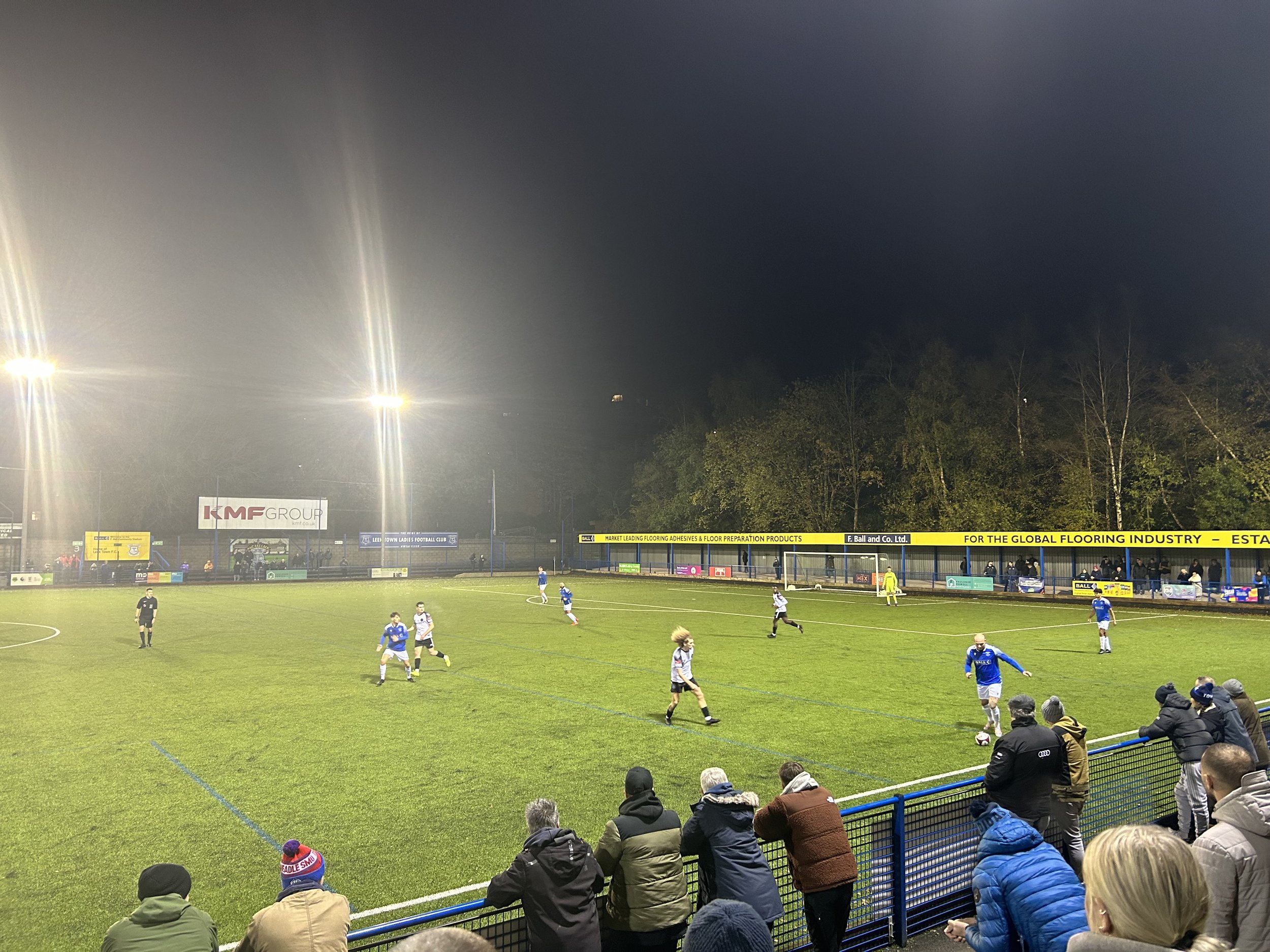
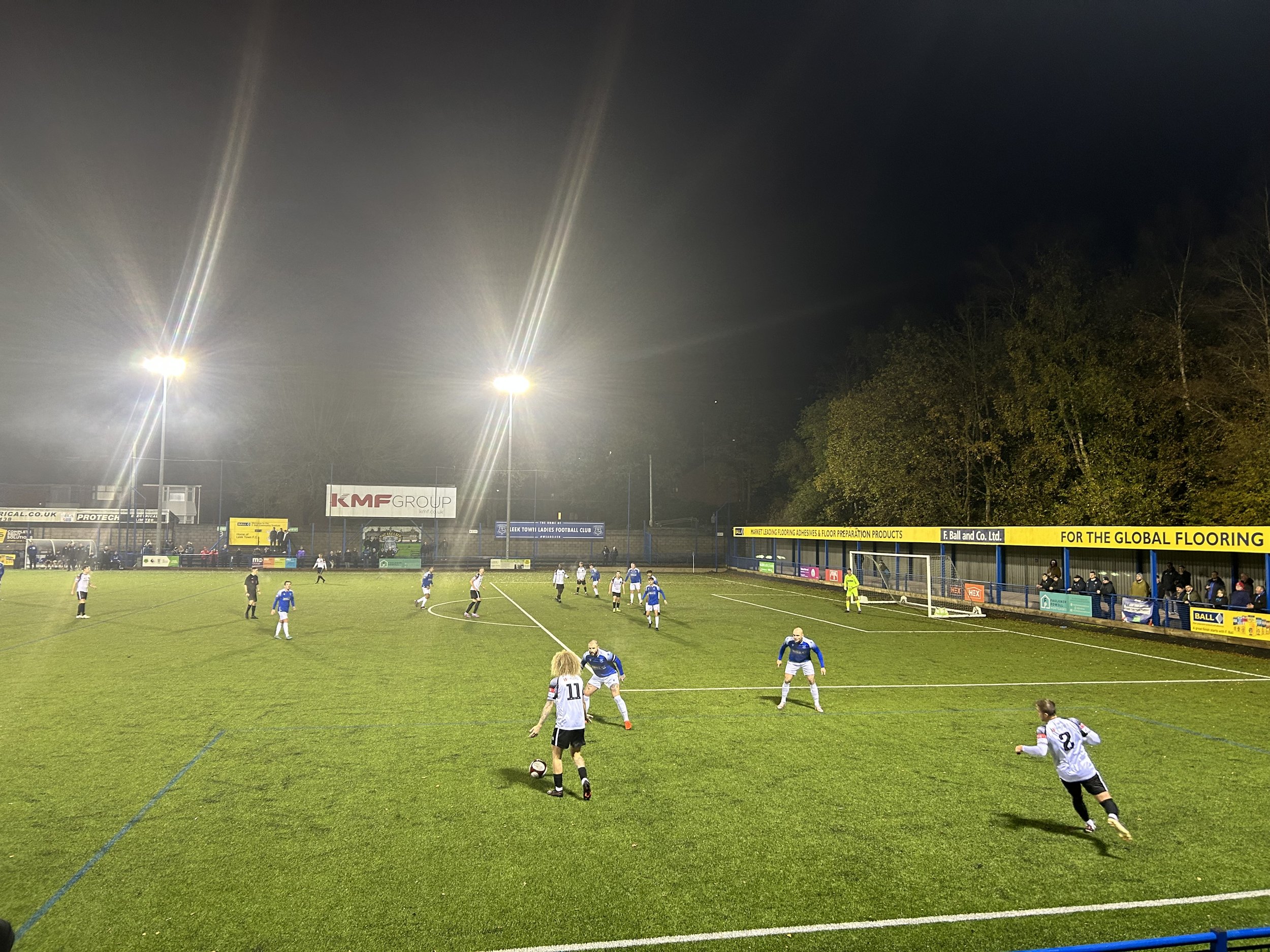
With the momentum in their favour at the end of the first half, and going into the second period with a player advantage, everything had changed, and Leek came out firing as the game restarted. The opening exchanges of the second half were almost a role reversal of how the game began, with Hanley this time under the cosh.
The game became very stop-start and scrappy, as more bookings followed. The referee did his best to manage a game which started to become a little heated. It may be a little harsh to say that Hanley tried to spoil the game, however the constant breaks in play certainly suited one side over the other. The home fans understandably became frustrated each time a Hanley player dawdled to collect the ball, or took a little too long to restart the game.
The supporters’ complains reached their vociferous peak when Hanley goalkeeper Adam Whitehouse was clattered into when gathering a low ball. The collision looked and sounded painful, but the supporters behind Whitehouse’s goal were less than sympathetic as he was off the field receiving treatment for at least a couple of minutes. Despite his visible discomfort, he was able to gather himself to deal with the corner kick that followed, however he then immediately fell to his knees, unable to continue, much to the ire of the Leek faithful.
After Whitehouse was replaced by young keeper Lennon Grimley, the game resumed, but a similar pattern followed. Leek continued to put pressure on the Hanley goal, and within minutes of his introduction, Grimley was picking the ball out of his net after the stubborn Hanley rearguard finally succummed.
A free kick from just inside the Hanley half was pumped into the box to test the new keeper and tired defence. Although the first ball was dealt with, Leek used their numerical advantage to recycle it and score from the second phase. A good cross from the left hand side was headed in at the far post by Olly Harrison to give the hosts a deserved 2-1 lead.
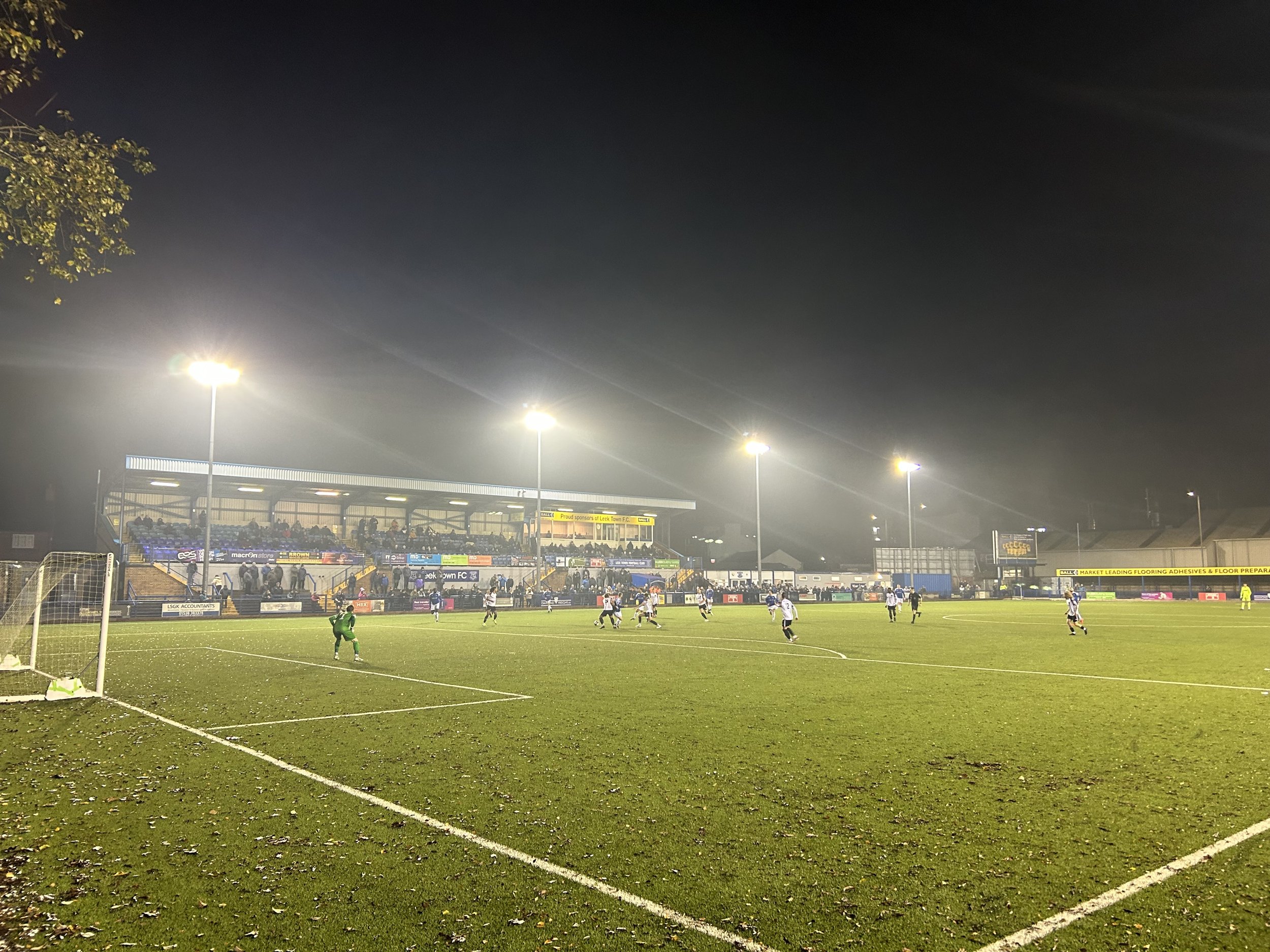
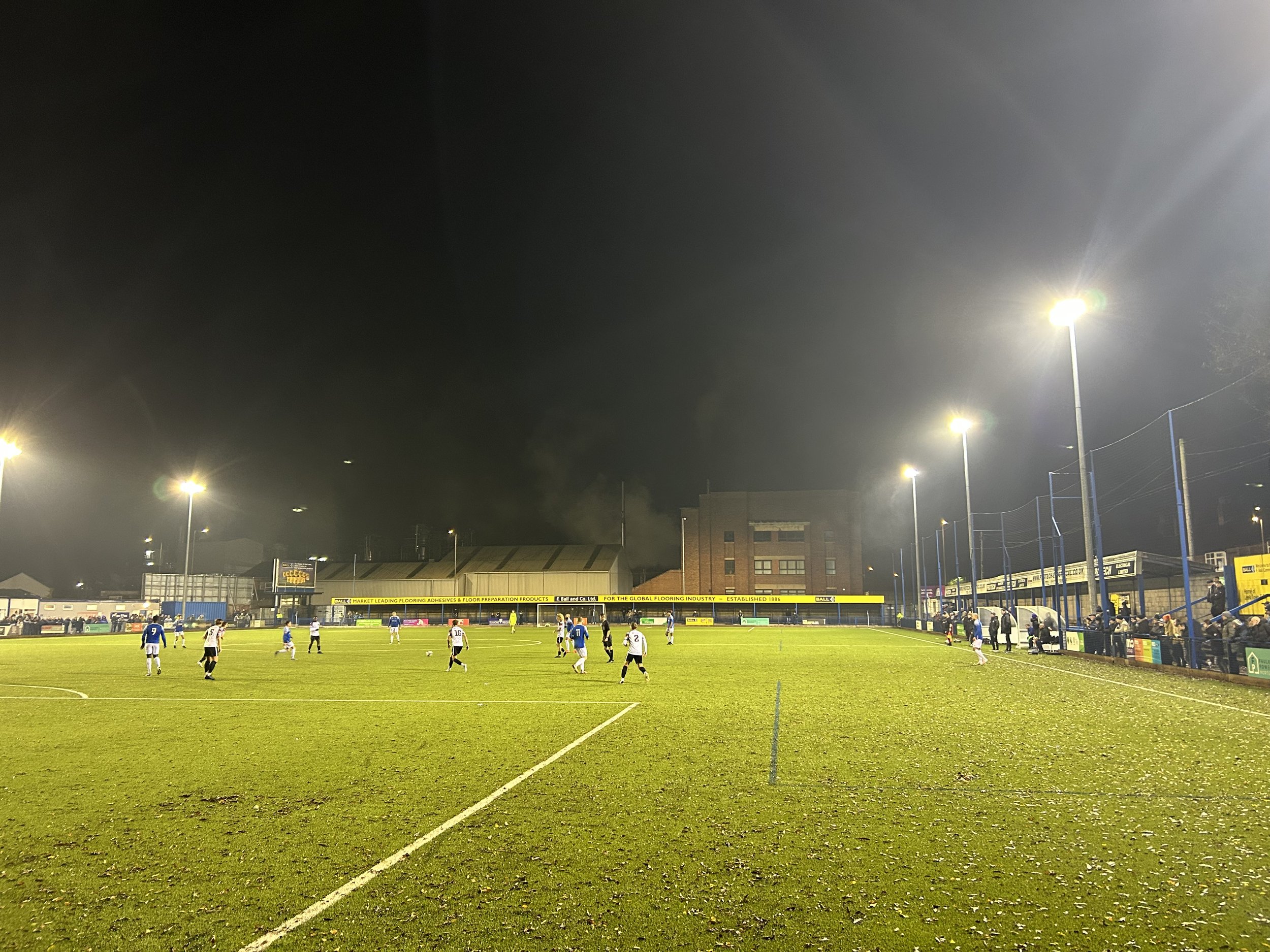
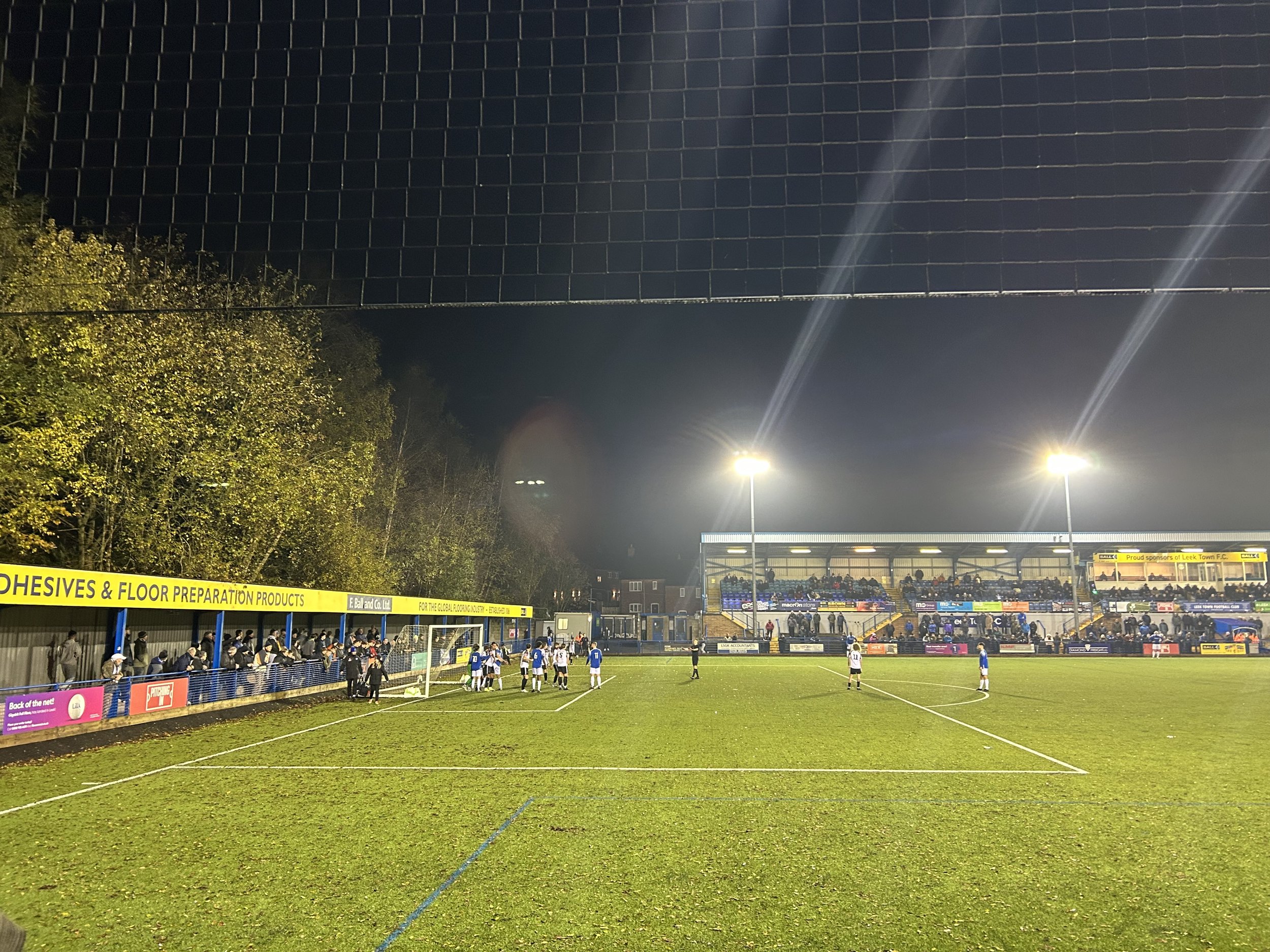
The remainder of the game continued to be played with an element of bad blood. By full time, the referee was very well acquainted with his pocket, not content with booking almost every player in white, he also cautioned a member of the Hanley coaching team, very audibly telling him he needs to calm down.
As the match reached its closing stages, it was now Leek’s turn to employ some game management, which they did effectively. Hanley began to take more risks, however apart for a long range effort from Ethan Stanton that sailed comfortably wide, they couldn’t muster an attack of note before the referee blew the final whistle.
Harrison Park is a traditional, yet clean and modern non-league ground. It has a unique quality which is an ability to maintain the charm and character of its past, whilst being incredibly functional for modern non-league football with its larger, more demanding crowds. The programme was fantastic, and the food was outstanding too. Furthermore, there is a warm feeling around the place, with a friendly welcome in all areas of the ground. I would very much recommend a visit to this ground that lies 10 miles north of Stoke, even on a cold Tuesday night. .
Final score: Leek Town 2-1 Hanley Town
Attendance: 582
Admission: £10
Programme: £2.50



